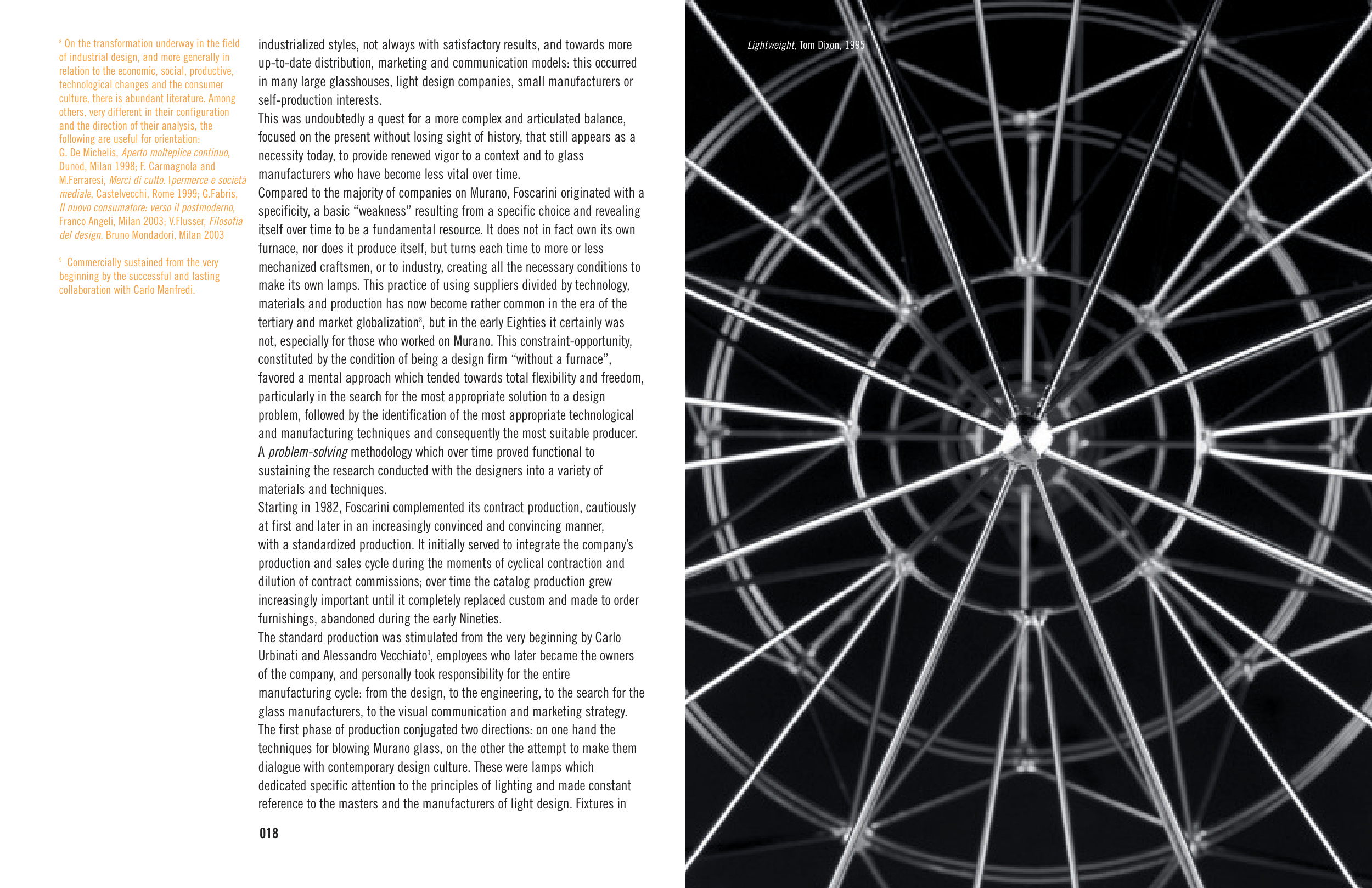018
Lightweight, Tom Dixon, 1995
industrialized styles, not always with satisfactory results, and towards more
up-to-date distribution, marketing and communication models: this occurred
in many large glasshouses, light design companies, small manufacturers or
self-production interests.
This was undoubtedly a quest for a more complex and articulated balance,
focused on the present without losing sight of history, that still appears as a
necessity today, to provide renewed vigor to a context and to glass
manufacturers who have become less vital over time.
Compared to the majority of companies on Murano, Foscarini originated with a
specificity, a basic “weakness” resulting from a specific choice and revealing
itself over time to be a fundamental resource. It does not in fact own its own
furnace, nor does it produce itself, but turns each time to more or less
mechanized craftsmen, or to industry, creating all the necessary conditions to
make its own lamps. This practice of using suppliers divided by technology,
materials and production has now become rather common in the era of the
tertiary and market globalization8, but in the early Eighties it certainly was
not, especially for those who worked on Murano. This constraint-opportunity,
constituted by the condition of being a design firm “without a furnace”,
favored a mental approach which tended towards total flexibility and freedom,
particularly in the search for the most appropriate solution to a design
problem, followed by the identification of the most appropriate technological
and manufacturing techniques and consequently the most suitable producer.
A problem-solving methodology which over time proved functional to
sustaining the research conducted with the designers into a variety of
materials and techniques.
Starting in 1982, Foscarini complemented its contract production, cautiously
at first and later in an increasingly convinced and convincing manner,
with a standardized production. It initially served to integrate the company’s
production and sales cycle during the moments of cyclical contraction and
dilution of contract commissions; over time the catalog production grew
increasingly important until it completely replaced custom and made to order
furnishings, abandoned during the early Nineties.
The standard production was stimulated from the very beginning by Carlo
Urbinati and Alessandro Vecchiato9, employees who later became the owners
of the company, and personally took responsibility for the entire
manufacturing cycle: from the design, to the engineering, to the search for the
glass manufacturers, to the visual communication and marketing strategy.
The first phase of production conjugated two directions: on one hand the
techniques for blowing Murano glass, on the other the attempt to make them
dialogue with contemporary design culture. These were lamps which
dedicated specific attention to the principles of lighting and made constant
reference to the masters and the manufacturers of light design. Fixtures in
8 On the transformation underway in the field
of industrial design, and more generally in
relation to the economic, social, productive,
technological changes and the consumer
culture, there is abundant literature. Among
others, very different in their configuration
and the direction of their analysis, the
following are useful for orientation:
G. De Michelis, Aperto molteplice continuo,
Dunod, Milan 1998; F. Carmagnola and
M.Ferraresi, Merci di culto. Ipermerce e società
mediale, Castelvecchi, Rome 1999; G.Fabris,
Il nuovo consumatore: verso il postmoderno,
Franco Angeli, Milan 2003; V.Flusser, Filosofia
del design, Bruno Mondadori, Milan 2003
9 Commercially sustained from the very
beginning by the successful and lasting
collaboration with Carlo Manfredi.


